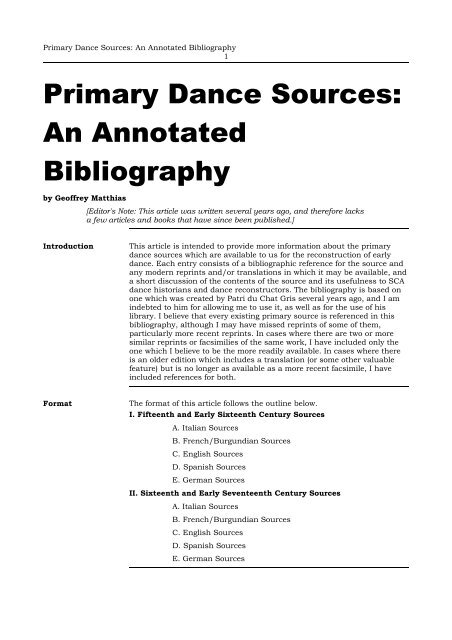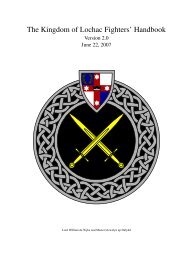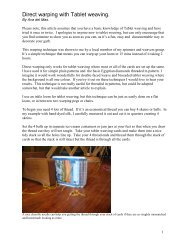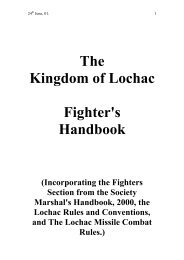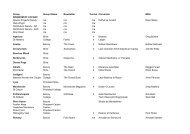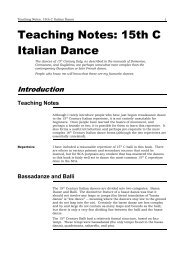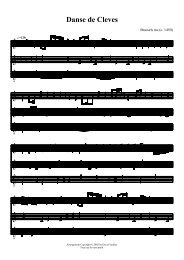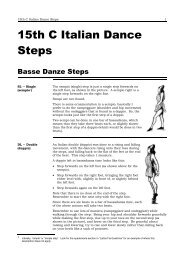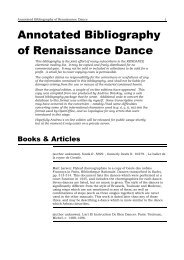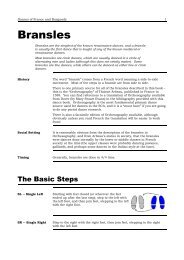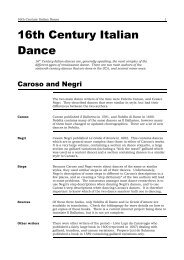Primary Dance Sources: An Annotated Bibliography
Primary Dance Sources: An Annotated Bibliography
Primary Dance Sources: An Annotated Bibliography
You also want an ePaper? Increase the reach of your titles
YUMPU automatically turns print PDFs into web optimized ePapers that Google loves.
<strong>Primary</strong> <strong>Dance</strong> <strong>Sources</strong>: <strong>An</strong> <strong>An</strong>notated <strong>Bibliography</strong><br />
1<br />
<strong>Primary</strong> <strong>Dance</strong> <strong>Sources</strong>:<br />
<strong>An</strong> <strong>An</strong>notated<br />
<strong>Bibliography</strong><br />
by Geoffrey Matthias<br />
[Editor's Note: This article was written several years ago, and therefore lacks<br />
a few articles and books that have since been published.]<br />
Introduction<br />
This article is intended to provide more information about the primary<br />
dance sources which are available to us for the reconstruction of early<br />
dance. Each entry consists of a bibliographic reference for the source and<br />
any modern reprints and/or translations in which it may be available, and<br />
a short discussion of the contents of the source and its usefulness to SCA<br />
dance historians and dance reconstructors. The bibliography is based on<br />
one which was created by Patri du Chat Gris several years ago, and I am<br />
indebted to him for allowing me to use it, as well as for the use of his<br />
library. I believe that every existing primary source is referenced in this<br />
bibliography, although I may have missed reprints of some of them,<br />
particularly more recent reprints. In cases where there are two or more<br />
similar reprints or facsimilies of the same work, I have included only the<br />
one which I believe to be the more readily available. In cases where there<br />
is an older edition which includes a translation (or some other valuable<br />
feature) but is no longer as available as a more recent facsimile, I have<br />
included references for both.<br />
Format<br />
The format of this article follows the outline below.<br />
I. Fifteenth and Early Sixteenth Century <strong>Sources</strong><br />
A. Italian <strong>Sources</strong><br />
B. French/Burgundian <strong>Sources</strong><br />
C. English <strong>Sources</strong><br />
D. Spanish <strong>Sources</strong><br />
E. German <strong>Sources</strong><br />
II. Sixteenth and Early Seventeenth Century <strong>Sources</strong><br />
A. Italian <strong>Sources</strong><br />
B. French/Burgundian <strong>Sources</strong><br />
C. English <strong>Sources</strong><br />
D. Spanish <strong>Sources</strong><br />
E. German <strong>Sources</strong>
2 <strong>Primary</strong> <strong>Dance</strong> <strong>Sources</strong>: <strong>An</strong> <strong>An</strong>notated<br />
<strong>Bibliography</strong><br />
Time Periods<br />
Section I covers manuals which date from approximately 1450-1550, while<br />
Section II covers those which date from 1550-1650. These dates were<br />
chosen to reflect the difference in dance styles which existed during these<br />
periods. For instance, while Arbeau discusses Basse <strong>Dance</strong>s, most of the<br />
sources for that style of dance fall in the earlier period (and there is<br />
evidence that Arbeau's Basse <strong>Dance</strong> is different from those which were<br />
done in the previous century). The separation by country is partly<br />
arbitrary, but also partly because of stylistic differences. <strong>An</strong> example is the<br />
difference between the Italian and Burgundian sources which deal with<br />
Basse <strong>Dance</strong>s during the first period. The Italian sources give dances<br />
which are much more free form, and require many more kinds of steps<br />
than do the Burgundian sources, which mainly give simple formulas for<br />
dances.<br />
Section I.A -- Fifteenth Century Italian<br />
<strong>Sources</strong><br />
Domenico da<br />
Piacenza<br />
Domenico da Piacenza. De arte saltandi & choreas ducendi (c.<br />
1450). Ms. in Paris, Bibliotheque Nationale (fonds it. 972). Published<br />
by Dante Bianchi. "Un trattato inedito di Domenico da Piacenza." La<br />
Bibliofilia. Florence. <strong>An</strong>no 65 (1963), pp. 109-149.<br />
Italian dance of the fifteenth century is the earliest form of dance for which<br />
written instructions have survived to the present. This is the earliest of<br />
those manuals, and according to some authorities, the best. Many of the<br />
dances described in this manual continue to appear in manuals up until<br />
the early sixteenth century, which gives an indication of their popularity.<br />
Italian dances of the time can be broken down into two general categories,<br />
bassadanza and balli. The difference between the two is primarily one of<br />
tempo and meter; bassadanza are always in 3/2 time, while the meter may<br />
change in the middle of balli, from 4/4 to 3/2 to 3/4, etc. There are often<br />
several such changes in a ballo, sometimes as many as four or five. Balli<br />
also tend to be more involved choreographically, including more complex<br />
steps and figures.<br />
This manual consists of 56 relatively small pages. The first thirteen of<br />
these contain instruction on how the dances and steps are to be<br />
performed, and the remainder of the manuscript consists of<br />
choreographies and their music. A total of fifteen choreographies are<br />
included.<br />
<strong>An</strong>tonio Cornazano.<br />
<strong>An</strong>tonio Cornazano. Libro dell'arte del danzare (1455). Ms. copy<br />
(c.1465) in Rome Biblioteca Aposolica Vaticana (Codex Capponiano,<br />
203). Published with notes by C. Mazzi. "Il
<strong>Primary</strong> <strong>Dance</strong> <strong>Sources</strong>: <strong>An</strong> <strong>An</strong>notated <strong>Bibliography</strong><br />
3<br />
This is currently the only one of the fifteenth century Italian treatises<br />
which is available in translation, and so is the earliest source easily<br />
accessible to most readers. <strong>An</strong>yone who is at all serious about fifteenth<br />
century dance should obtain a copy, although consultation of the original<br />
and other sources in the Italian are a must for any serious reconstruction<br />
of the dances. About two fifths of the book contains a discussion of the<br />
qualities which one needs for dancing, such as Memory, Measure, Manner,<br />
Spirit, Variety and Use of Space. These generalities give way to a<br />
discussion of tempo and steps, although the step descriptions given are<br />
hazy and open to multiple interpretations (as is usually the case with<br />
these manuals). The remaining three fifths of the book are given over to<br />
descriptions of dances, balli and bassedanza, some of which appear in the<br />
other available sources.<br />
Guglielmo Ebreo<br />
Guglielmo Ebreo. Guglielmi Hebraei pisauriensis de pratica seu arte<br />
tripudii vulgare opusculum (1463). Ms. (by the amanuensis Paganus<br />
Raudensis) in Paris, Bibliotheque Nationale (fonds it. 973).<br />
unpublished.<br />
All of the manuals attributed to Guglielmo Ebreo are roughly similar in<br />
structure (note that by manual I mean a work which includes information<br />
on how the dances and steps are to be performed, not just<br />
choreographies). The discussion in each is broken down into<br />
classifications in a similar fashion to Cornazano, including sections on<br />
Measure, Memory, Use of Space, etc. The differences are primarily small<br />
changes in the exact wording, although some manuals include sections<br />
that are not in others, and some sections are more extensive in some<br />
manuals. The primary difference between the manuals is how many<br />
choreographies each includes, and which they are. <strong>An</strong>other difference is<br />
whether the manual includes music for the dances or not.<br />
This particular manuscript consists of one hundred and three small pages.<br />
The first forty three discuss steps and their performance. The remainder of<br />
the manual includes choreographies for thirty one dances, fourteen<br />
bassadanze and seventeen balli. The last few pages contain the music for<br />
the dances.<br />
Guglielmo Ebreo. Untitled (c. 1460). Ms. in Foligno, Seminario<br />
Vescovile, Biblioteca L. Jacobilli (MS D.I. 42). Published (as a nuptial<br />
offering to the couple Renier-Campostrini) by Michele Faloci-<br />
Pulignani. Otto bassdanze di M. Guglielmo de Pesaro e de M.<br />
Domenico da Ferrara (Foligno: 1887).<br />
This is a short manuscript which contains the choreographies for 8<br />
bassadanza. It includes no music, nor is there an introductory section<br />
discussing steps. Among the dances are Pelygryna and La Reale.<br />
Guglielmo Ebreo. De praticha seu arte tripudii vulgare opsculum,<br />
Ghuglielmi hebrei Pisauriensis. Ms. in Florence, Biblioteca Nazionale<br />
Centrale (Codex Magliabecchiana-Strozziano XIX, 9, Nr. 88).<br />
Published by Francesco Zambrini. Trattato dell'arte del ballo di<br />
Guglielmo Ebreo, pesarese (Bologna: 1873). Reprinted by Forni<br />
(Bologna: 1968).
4 <strong>Primary</strong> <strong>Dance</strong> <strong>Sources</strong>: <strong>An</strong> <strong>An</strong>notated<br />
<strong>Bibliography</strong><br />
This manuscript contains the usual section discussing steps, and a total<br />
of thirty four dances, seventeen bassadanza and seventeen balli. As usual,<br />
most of the dances can be found in other sources. No music is included.<br />
Guglielmo Ebreo. Trattato della danza composto da Maestro<br />
Guglielmo ed in parte cavato dell'opera di Maestro Domenico,<br />
Cavagliere Piacentino (n.d.). Ms. in Siena, Biblioteca Comunale<br />
(Codex V. 29). Published, with omission of passages agreeing with<br />
Zambrini (above) and Roncaglia (below) versions, by Curzio Mazzi.<br />
"Una sconosciuta compilazione di un libro quattrocentistico di balli."<br />
La Bibliofilia. Florence: <strong>An</strong>no 16 (1915), pp.185-209.<br />
This source in nearly identical to the above source, except that it includes<br />
many dances which are not in the other. It includes a total of sixty four<br />
dances, of which thirty are bassadanza and thirty four are balli. This<br />
source does not include any music.<br />
Guglielmo Ebreo. Title page absent. Ms. in Modena, Biblioteca<br />
Estense (Ital. 82, a.J.9.4. (formerly VII.A.82)). Published by Giovanni<br />
Messori Roncaglia. Della virtue et arte del danzare... (Modena:<br />
1885).<br />
This manuscript is relatively small, only fifty eight pages, and includes the<br />
usual section concerning steps and dancing in general. This is followed by<br />
a relatively small number of dances, five bassadanza and ten balli. No<br />
music is included.<br />
Guglielmo Ebreo (G. Ambrosio). Domini Iohannis Ambrosii<br />
Pisauriensis de Practica seu arte Tripudii Vulgare Opusculum. Ms.<br />
in Paris, Bibliotheque Nationale (fonds it. 476). Unpublished.<br />
This is a relatively thick manuscript, with some 161 relatively small pages.<br />
It is similar in structure to most of the major sources of the period,<br />
beginning with the usual section on steps, and proceeding on to specific<br />
choreographies. Thirty six choreographies are included, fifteen bassadanza<br />
and twenty one balli, as well as the music for them. This source is an<br />
excellent place for a person who wishes to begin reconstructing fifteenth<br />
century Italian dances to begin, since it includes discussion on steps,<br />
music and a large number of interesting dances. The only drawback is, of<br />
course, that it is in Italian and has not been translated.<br />
Guglielmo Ebreo. Guglielmus ebreis pisauriensis de pracha seu arte<br />
tripudi vorghare opusculum. Ms. (dated 6 December 1510 (or<br />
possibly 1540)) in Florence, Biblioteca Medicea-Laurenziana (Codex<br />
<strong>An</strong>tinori A 13). Unpublished.<br />
This source is made up of ninety pages of text, and like the following<br />
source, is written in a hand that is very difficult to read. It contains the<br />
usual remarks on the art of dancing, and a relatively large section of<br />
choreographies. Eighteen bassadanza and twenty one balli are included.<br />
No music is given.
<strong>Primary</strong> <strong>Dance</strong> <strong>Sources</strong>: <strong>An</strong> <strong>An</strong>notated <strong>Bibliography</strong><br />
5<br />
Guglielmo Ebreo. Guglielmi ebrei pisaurienses de pracha seu arte<br />
tripudi vulghare opuschulam feliciter incipit senper chongratia sia<br />
di dio senper. Ms. (originally owned by Giorgio del Giudeo (c. 1470),<br />
donated by Walter Toscanini) in New York, Public Library, <strong>Dance</strong><br />
Collection (Cia Fornaroli Coll. (S) *MGZMB-Res. 72-254). Unpublished.<br />
This manuscript contains some thirty seven large pages of very difficult to<br />
read writting. The first nine pages are discussion of dance and how the<br />
steps are performed, while the remaining pages give choreographies for<br />
fifty five separate balli and bassadanza. No music is included, but many of<br />
the dances appear in other manuscripts in which the music is recorded.<br />
This manuscript is not for the faint of heart, as the handwriting is almost<br />
illegible, and no transcription exists. It does, however, contain a wealth of<br />
valuable information. It is also one of the few sources which is in the U.S.,<br />
which makes it somewhat more available, at least to those who live on the<br />
east coast.<br />
Guglielmo Ebreo. Untitled. Ms. fragment in Florence, Biblioteca<br />
Nazionale Centrale (Fondo Palatino 1021, ff. 105r-106v.).<br />
Unpublished.<br />
This is a relatively minor source, being a pair of pages which are all that<br />
are left of a Guglielmo manual. They are from the section on how dances<br />
are performed, so they are of some use in reconstructing steps. Their use<br />
is limited, however, by the fact that they are not that different from the<br />
more complete manuals, and by their brevity.<br />
Section I.B -- Fifteenth Century<br />
French/Burgundian <strong>Sources</strong><br />
Brussles MS.<br />
Brussles, Bibliotheque Royale, Ms 9085. Facsimile with introduction<br />
and transcription by Ernest Closson. Le manuscrit dit des basses<br />
danses de la bibliotheque de bourgogne (Brussles: 1912). The above<br />
facsimile (with introduction) has been reprinted by Minkoff.
6 <strong>Primary</strong> <strong>Dance</strong> <strong>Sources</strong>: <strong>An</strong> <strong>An</strong>notated<br />
<strong>Bibliography</strong><br />
All the manuals discussed in this section except the last are in french, and<br />
describe the style of basse dance which was popular in France and<br />
Burgundy in the late fifteenth and early sixteenth century. These dances<br />
are similar to the Italian bassadanza which is described in numerous<br />
manuscripts from 1450 until about 1510 (see section I.A). Unlike the<br />
Italian sources, the Burgundian manuals contain few complicated dances,<br />
and use a much smaller vocabulary of steps.<br />
This manuscript includes a short discussion on steps for the Burgundian<br />
style of basse dance, which are processional in nature, beginning with a<br />
reverence (i.e. bow) and branle, followed by some combination of single<br />
steps, double steps, reprises and branles. The most well-known of these<br />
dances in the SCA are <strong>Dance</strong> de Cleves and Fransois Nouvele, both<br />
reconstructed from this manuscript. This work includes a list of 59<br />
bassedances, along with music. The music given is only the tenor line, as<br />
the musicians were expected to improvise one or two more parts around<br />
the base given to the tenor. The introduction by Closson is dated, and has<br />
been supplanted by newer scholarship.<br />
Michel Toulouze, pub Michel Toulouze, pub. L'art et instruction de bien dancer (Paris: c.<br />
1488-1496). Published in facsimile with music transcribed and<br />
edited by Richard Rastall and translated by A. E. Lequet (New York,<br />
<strong>Dance</strong> Horizons: 1971). Published in facsimile by Minkoff (Geneve:<br />
1985).<br />
This work is considered to be the first printed work on dancing, with all<br />
earlier works being manuscripts, and so would have been available to a<br />
larger audience than any previous work. Like the Brussles Manuscript<br />
above, this work includes a short discussion on steps and a list of 45<br />
basse dances, with the music for their tenor lines. Some dances appear in<br />
Brussles or Moderne, as well as here. For the interested scholar who does<br />
not read french, this volume is valuable for the translation of the<br />
introductory discussion of steps, although the translation is not perfect. It<br />
should be noted that the discussion of dancing and in particular the<br />
descriptions of steps which appear here and in Brussles and Moderne are<br />
far from clear and concise, but must be considered carefully when<br />
attempting to interpret the steps. Given an interpretation of the steps, the<br />
actual dance choreographies are relatively unambiguous.<br />
Le ballet de la royne<br />
de Cessile<br />
Le ballet de la royne de Cessile. Flyleaf choreographies to a copy of<br />
Geste des nobles Francoys in Paris, Bibliotheque Nationale (fonds fr.<br />
5699 (formerly fonds fr. 10279)). <strong>Dance</strong>s transcribed in Curt Sachs,<br />
World History of the <strong>Dance</strong> (New York: 1937), pp. 313-314.<br />
This document lists the dances which were performed at a court function<br />
in 1445, and includes the choreogrophies for each dance. Seven dances<br />
are listed, but no music is given. The style of the dances is signifigantly<br />
different from the style of Brussles, Toulouze and Moderne, using steps<br />
which are not mentioned in any of them, as well as combinations of steps<br />
(such as three singles together) which are never used in the other<br />
manuals. This work is dated later than any of those three, and may be<br />
describing a dance which is more similar to the dance which Arbeau<br />
describes.
<strong>Primary</strong> <strong>Dance</strong> <strong>Sources</strong>: <strong>An</strong> <strong>An</strong>notated <strong>Bibliography</strong><br />
7<br />
Jacques Moderne<br />
S'ensuyvent plusiers basses dances, tant communes que<br />
incommunes, comme on pourra veoyr cy dedans (Lyon: press of<br />
Jacques Moderne, c. 1532-1533). Only known copy in Paris,<br />
Bibliotheque Nationale (Coll. Rothschild, VI-3 bis-66, No. 19). Brief<br />
study and edition of the dances published by Francois Lesure.<br />
"<strong>Dance</strong>s et chansons a danser au debut du XVIe siecle." Recuil de<br />
travaux offerts aM. Clovis Brunel vol. II, pp. 176-184. Facsimile<br />
reprint by Minkoff (Geneve: 1985).<br />
Includes a short discussion on steps and a list of 115 basse dances,<br />
although without the music. Many of the dances also appear in Brussles<br />
and Toulouze. The introduction given by Moderne is very similar to that<br />
given by Toulouze, and may have been a rewritting of it.<br />
Torino Ms<br />
Torino Ms. Untitled single sheet (dated 27 december 1517) in Torino,<br />
Archivi Biscaretti (Mazzo 4, No. 14). Published by P. Meyer. "Role de<br />
chansons a danser du XVI siecle." Romania. Paris. Vol. 23 (1894), pp.<br />
156-60.<br />
This sheet includes notation for 20 dances in the style of Brusseles,<br />
Moderne and Toulouze, including some dances which are listed in those<br />
works. As with Moderne, no music is given; however, the article in<br />
Romania suggests some possible tunes for some of the choreographies.<br />
<strong>An</strong>tonius de Arena <strong>An</strong>tonius de Arena. Ad Suos compagniones studiantes. (Avignon: c.<br />
1520), and many subsequent editions. Translation by John Guthrie<br />
and Marino Zorzi. "Rules of Dancing" in <strong>Dance</strong> Research, the Journal<br />
of the Society for <strong>Dance</strong> Research. London. Vol. IV, #2, Autumn<br />
1986, pp. 3-53.<br />
This is a treatise on the basse dance and dance etiquette, written in latin.<br />
It was apparently intended for law students at the University of Avignon,<br />
who were familiar with some dances but not basse dances. Included are<br />
19 basse dances, but no music. A large part of the text is devoted to telling<br />
"middle class" law students what was and was not proper on the dance<br />
floor. The instructions which are given for steps are minimal and, as<br />
usual, far from clear. They are also difficult to resolve with instructions<br />
from other manuals and therfore pose an interesting problem to dance<br />
historians.<br />
It has been noted that the choreographies which Arbeau gives for basse<br />
dances are included in Arena, which has lead to speculation that Arbeau<br />
may have used Arena as a source for a dance which he himself was not<br />
completely familiar with. He would certainly have had access to Arena,<br />
since it was reprinted in many editions over a span of more than two<br />
centuries, with the last reprint being about 1758.
8 <strong>Primary</strong> <strong>Dance</strong> <strong>Sources</strong>: <strong>An</strong> <strong>An</strong>notated<br />
<strong>Bibliography</strong><br />
Section I.C -- Fifteenth Century English<br />
<strong>Sources</strong><br />
Robert Copeland<br />
Robert Copeland. The manner of dauncynge of bace daunces.<br />
Translation of an unknown French source appended to his<br />
publication of a French grammar by Alexander Barclay. The<br />
introductory to wryte and to pronounce Frenche (London: 1521).<br />
Only copy in Oxford, Bodleian Library (Douce B. 507). Published by<br />
Mabel Dolmetch. <strong>Dance</strong>s of England and France from 1450 to 1600<br />
(London: 1949), pp. 2-4. Reprinted by Da Capo Press (New York:<br />
1975).<br />
This source is very similar to some of the French sources from the fifteenth<br />
century, particularly Tolouze, Moderne and the Brussles manuscript,<br />
although this source is somewhat more brief. It includes a number of the<br />
choreographies which appear in the other sources, although it contains no<br />
music and offers fewer choreographies than the French sources. The<br />
discussion is also more brief than that in the other sources, but the<br />
information which is there is very similar to parts in the others.<br />
Salisbury Ms<br />
Salisbury Ms. Untitled, undated flyleaf choreographies in copy of<br />
Joh. de Janua. Catholicon (Venice: 1497). Facsimile and<br />
transcription with notes published by Daniel Heartz. "The Basse<br />
<strong>Dance</strong>." <strong>An</strong>nales Musicologiques, VI (1958-1963), bet. pp. 310-311,<br />
pp. 337-340.<br />
This source offers twenty six choreographies in the style of the French<br />
fifteenth century sources. No music is included. Some of the twenty six<br />
choreographies are identical, perhaps intended to be danced to different<br />
music, although with the same steps. Others are to be found in some of<br />
the French manuals of the same period.<br />
Sir Thomas Elyot Sir Thomas Elyot. The Boke Named the Governor (London: 1531).<br />
Facsimile published by The Scolar Press (Menston, England: 1970).<br />
Modern reprint edited by S. E. Lehmberg (London and New York,<br />
Everyman's Library, J. M. Dent & Sons: 1962). (Chapters 19 through<br />
25 deal with dancing).<br />
The chapters which discuss dancing are interesting, although not of direct<br />
use in reconstructing choreographies. No specific choreographies are<br />
given, nor is any music included. What is given, however, is information<br />
about how dances were done in England at this time. It is fairly clear that<br />
the dances were basically similar, if not identical to those which were done<br />
in France and Burgundy at this time. We can also glean some style<br />
information, so this source is more useful to those working on how the<br />
steps were performed than it is to those who are interested only in specific<br />
reconstructions.
<strong>Primary</strong> <strong>Dance</strong> <strong>Sources</strong>: <strong>An</strong> <strong>An</strong>notated <strong>Bibliography</strong><br />
9<br />
Section I.D -- Fifteenth Century Spanish<br />
<strong>Sources</strong><br />
Cervera Ms<br />
Cervera Ms. Untitled, undated (c. 1496) pair of paper sheets<br />
preserved in a notarial manual in Cervera, Archivo Historico (fonds<br />
notarial 3,3). Facsimile in volume edited by F. Carreras y Candi.<br />
Folklore y Costumbres de Espana. 2nd ed. (Barcelona: 1934), vol. I,<br />
p. vii; vol. II, p. 303.<br />
This source is two sheets of what appear to be choreographic notations for<br />
basse dances. It is of interest primarily because it uses a curious notation<br />
to set down the choreographies. The style of the dances is more similar to<br />
the Burgundian dances of about the same period than it is to the Italian<br />
bassadanza and balli. The sheets do not include music, although some of<br />
the titles of the dances correspond to music which is found in other<br />
sources.<br />
Section I.E -- Fifteenth Century German<br />
<strong>Sources</strong><br />
Nurnberg Ms<br />
Nurnberg Ms. "Hie Jnnen sindt geschriben die wellschen tenntz."<br />
Brief, undated (c. 1517) ms. in Nurnberg, Germ. Nat. Mus. (MS 8842).<br />
Discussion with facsimile of single page in Ingrid Brainard. "The Art<br />
of Courtly Dancing in Transition...", Crossroads of Midieval<br />
Civilization..., ed. E. E. Dubruck and K. H. Goller. In Medieval and<br />
Renaissance Monograph Series, V (Michigan: Michigan Consortium<br />
for Mideval and Early Modern Studies, 1984), pp. 61-79.<br />
This is a small manuscript, consisting of seven pages. It offers eight<br />
choreographies, but no music or description of how the steps are<br />
performed is included. Dr. Brainard attributes this source to one<br />
Johannes Cochlaus, a German who was at the university of Bologna. The<br />
manuscript was apparently compiled for a pair of young ladies in<br />
Nurnberg, who desired some knowledge of current fashion in Italian<br />
dancing, for use at local dances. Most of the included dances appear in the<br />
Italian sources of the period, but this source offers a point of view other<br />
than that of a dancing master.
10 <strong>Primary</strong> <strong>Dance</strong> <strong>Sources</strong>: <strong>An</strong> <strong>An</strong>notated<br />
<strong>Bibliography</strong><br />
Section II.A -- Sixteenth Century Italian<br />
<strong>Sources</strong><br />
Marco Fabrito<br />
Caroso<br />
Marco Fabrito Caroso. Il Ballarino (Venice: 1581). Facsimile reprint<br />
by Broude Brothers (New York: 1967).<br />
All the Italian manuals of this period follow a similar format, and discuss<br />
dances of the same style. First they discuss steps, usually in fairly great<br />
detail, although not always completely clearly. They then go on to give<br />
specific choreographies for dances, sometimes including the music in lute<br />
tabulature or score, or both. As one would expect, they were all originally<br />
written in Italian, although English translations exist for some of them.<br />
The step descriptions vary from quite easy to understand to very difficult<br />
(the most difficult are usually galliard and canary steps). It should be<br />
noted that different authors sometimes call different steps by the same<br />
name, or give different names to the same step.<br />
The choreographies which are given are almost always lengthy (the<br />
shortest one which I am familiar with takes a couple of minutes to dance,<br />
and most of the choreographies are two or three times as long), and are<br />
fairly difficult both to dance and to reconstruct. It is clear that the nobles<br />
which danced these dances were very skilled dancers who delighted in<br />
difficult and complicated figures, which would show their skill.<br />
The general format for most of the dances consists of several sections of<br />
relatively simple walking steps (similar to pavan or alman steps), which are<br />
fairly easy to reconstruct. Interspersed with these sections are very<br />
complicated figures of galliard and canary steps, the simplest of which<br />
rival the most difficult which Arbeau describes. These sections can be very<br />
difficult to reconstruct with any confidence.<br />
This particular manual, Il Ballarino, or The Dancing Master, is the first of<br />
the Italian manuals of this era to be published. It contains two sections,<br />
one on steps and dance manners, and one which contains choreographies.<br />
The second section includes eighty dances, with lute tabulature for the<br />
accompanying music, as well as scores for some of the dances.<br />
Marco Fabrito Caroso. Nobilta di Dame (Venice: 1600). Facsimile<br />
reprint by Forni Editore, Bologna. Translated with introduction by J.<br />
Sutton (Oxford: Oxford University Press, 1986).
<strong>Primary</strong> <strong>Dance</strong> <strong>Sources</strong>: <strong>An</strong> <strong>An</strong>notated <strong>Bibliography</strong><br />
11<br />
Caroso's second book is a refinement of the first, to the extent that the<br />
cover page subtitles it the "Second Edition of the Book Called Il Ballarino."<br />
This is in spite of the fact that only some twenty of the forty-nine dances<br />
presented in it duplicate dances found in the previous volume. But while it<br />
is not a true second edition, there are many additions and refinements to<br />
both the "rules" for the steps and the dances themselves. As a result, any<br />
reconstruction of one of the dances which appears in both volumes should<br />
rely on the second for the definitive version. Even when reconstructing a<br />
dance from Il Ballarino which does not appear in Nobilta di Dame, one<br />
should examine the step descriptions in the second volume, since they are<br />
in general more clear and precise. Julia Sutton's translation makes this<br />
one of the more accessible of the sixteenth century Italian sources, but one<br />
should be careful not to rely too heavily on it in creating reconstructions,<br />
as there are always nuances lost, however good the translation may be.<br />
Marco Fabrito Caroso. Raccolta di varij balli... (Rome: 1630).<br />
Essentially a reprinting of Nobilta di Dame with a new title.<br />
Cesare Negri<br />
Cesare Negri. Le gratie d'amore (Milan: 1602) Facsimile reprint<br />
Broude Brothers (New York: 1969). Translation and Facsimile by<br />
Gustavia Yvonne Kendall, "Le Gratie D'Amore" 1602 by Cesare Negri:<br />
Translation and Commentary. PhD dissertation (Stanford University:<br />
1985).<br />
Like the other Italian manuals of the sixteenth century, this is a large<br />
volume of long and very difficult dances. In particular this volume includes<br />
a long discussion on galliard variations, and gives many galliard steps,<br />
including steps used for the "kick the tassel" contest. It should be noted<br />
that Negri uses some of the same names as Caroso for what seem from the<br />
descriptions to be different steps, so one should use care when<br />
reconstructing a dance to use the appropriate steps.<br />
On average, the dances which Negri presents are more complicated than<br />
those which Caroso offers. That is, the simplest of Negri's dances is more<br />
complicated than the simplest of Caroso's; although the most difficult<br />
dances of each author are similar in complexity.<br />
Kendall's translation is a very valuable volume, since it offers both a<br />
facsimile of the original and a translation. Thus, when reconstructing a<br />
dance, it is easy to refer to the original at any point, but the work is also<br />
accessible to those who don't know italian. The translation is not<br />
completely reliable, however, and some reference to the facsimile should<br />
be made.<br />
Cesare Negri. Nuove inventioni di balli (Milan: 1604).<br />
This volume was a reprint of Negri's previous volume, Le gratie d'amore.<br />
Livio Lupi da<br />
Carravagio<br />
Livio Lupi da Carravagio. Libro di gagliarda, tordiglione, passo e<br />
mezzo, cannarii e passeggi... (Palermo: 1607).
12 <strong>Primary</strong> <strong>Dance</strong> <strong>Sources</strong>: <strong>An</strong> <strong>An</strong>notated<br />
<strong>Bibliography</strong><br />
This is a lengthy volume (about 300 pages) discussing, as the title<br />
suggests, galliards, tordions, passo e mezzo and cannaries. It opens with a<br />
short disscussion of steps and choreographies for two dances. The<br />
majority of the volume, however, is devoted to describing hundreds of<br />
short sequences of galliards, tordions, etc. These are apparently intended<br />
for use when one needed to "invent" a galliard or other variation. The<br />
reader would memorize and practice several passages from each section,<br />
so as to have them ready at need. It is difficult to imagine anyone<br />
memorizing all of the literally hundreds of variations offered here, but it is<br />
clear that no one would have been considered an accomplished dancer<br />
without knowing a few (or better yet, being able to invent them as needed).<br />
All in all, an interesting volume, but not as generally useful as either of<br />
Caroso's works or Negri's book.<br />
Propero Luti de<br />
Sulmona<br />
Propero Luti de Sulmona. Opera bellissima nella quale si contegono<br />
multe partite, et passeggi di gagliarda... (Perugia: 1589).<br />
This work is similar to that of Lupi above, but much shorter. The<br />
discussion of steps is a single page, speaking mostly about caprioles, and<br />
only some thirty-two variations are presented. Only galliard variations are<br />
discussed.<br />
Il Papa Ms<br />
Il Papa Ms. New York, Public Library, <strong>Dance</strong> Collection (Cia Fornaroli<br />
Coll. *ZBD-26); Florence, Biblioteca Nazionale Centrale (Codex<br />
Magliabecchiana-Strozziano XIXm cod. 31).<br />
This is a relatively short manuscript, made up of some fourteen double<br />
sided pages. It is written in a hand which is fairly difficult to make out,<br />
and contains no music for its dances. The first two pages are introductory<br />
in nature, and discuss dance in general. The remaining twelve pages<br />
contain a total of fifteen dance choreographies. Some of these<br />
choreographies are relatively long, while others are quite short, as short or<br />
shorter than the shortest offered by Caroso. Although this is a relatively<br />
minor source from this period, it is available in the US.<br />
Felippo de gli<br />
Alessandri<br />
Felippo de gli Alessandri. Discorso sopra il ballo (Terni: 1620).<br />
I have not been able to run down a copy of this source at all. If anyone has<br />
a copy or knows where one can be obtained, I would love to hear about it!
<strong>Primary</strong> <strong>Dance</strong> <strong>Sources</strong>: <strong>An</strong> <strong>An</strong>notated <strong>Bibliography</strong><br />
13<br />
Section II.B -- Sixteenth Century French<br />
<strong>Sources</strong><br />
Thoinot Arbeau<br />
Thoinot Arbeau (<strong>An</strong>agram for Jehan Tabourot). Orchesographie<br />
(Lengres: 1589; 2nd ed. 1596). Translated by Cyril W. Beaumont<br />
(London: 1925; reprinted by <strong>Dance</strong> Horizons, New York: 1968).<br />
Translated by Mary S. Evans (Kamin <strong>Dance</strong> Pub., 1948; reprinted<br />
with introduction and notes by Julia Sutton and labanotation by M.<br />
Becker and J. Sutton by Dover Pub., New York: 1967).<br />
This manual is the best known original source within the SCA, because of<br />
its wide availability. It contains a wide variety of dances, many fairly<br />
simple in description and therefore easy to reconstruct. As with most<br />
manuals of the time, the more complicated instructions are open to<br />
multiple interpretations, and are often very confusing. Attempts to<br />
reconstruct these dances are best done with reference to the original<br />
French, since there are many nuances lost in translation. This is a work<br />
worthy of being re-examined from time to time, as one will often rediscover<br />
some detail which had been forgotten. Persons interested in learning about<br />
reconstructions may want to start with this work, since it offers the<br />
opportunity to examine descriptions of dances which one already knows,<br />
and see how other people have reconstructed dances.<br />
Francois de Lauze<br />
Francois de Lauze. Apologie de la Danse (n.p.: 1623). Facsimile<br />
reprint by Minkoff (Geneva: 1977). Modern reprint with translation<br />
and notes by Joan Wildeblood (London: Frederick Muller Ltd, 1952).<br />
This manual describes in great detail a number of the dances popular in<br />
the early seventeenth century, including the courante, several different<br />
bransles, the galliard, as well as a few words on the gavotte. One<br />
interesting feature is that the work is composed of two separate manuals,<br />
one for gentlemen, and the other for ladies. To the best of my knowledge,<br />
this is the first dance manual which indicates that the man is doing steps<br />
(other than the bow) which are significantly different from those which the<br />
woman is doing. The manual is dedicated to George Villiers, then Marquis<br />
of Buckingham.<br />
The descriptions are probably meant to discuss the same movements<br />
which Arbeau and others describe (de Lauze actually refers the reader to<br />
Arbeau in one instance), but de Lauze's descriptions are so detailed and<br />
involved that it is difficult to understand what he is trying to get across.<br />
Thus, while this is a valuable work, it is very difficult to make definitive<br />
interpretations of the descriptions. One cannot help but feel, however, that<br />
careful reading of the manual and much work would yield some very<br />
valuable insights. In short, this manual offers a lot of promise, but ought<br />
not to be tackled unless one is willing to exert a great deal of effort.<br />
B. de Montagut B. de Montagut. "Lovange de la <strong>Dance</strong>" (c.1623). Ms. in London,<br />
British Museum (MS Royal 16E, 37-39). Unpublished.
14 <strong>Primary</strong> <strong>Dance</strong> <strong>Sources</strong>: <strong>An</strong> <strong>An</strong>notated<br />
<strong>Bibliography</strong><br />
Like the above manual by de Lauze, this describes early seventeenth<br />
century court dancing, in which one can see the beginnings of what will<br />
become baroque dance in the next century. It begins with a discussion of<br />
the "principles" of dance, continues with a section on the reverence,<br />
followed by detailed discussions of the courante, bransles and galliardes<br />
(with a specific section discussing the capriole).<br />
This work is similar in many ways to that of de Lauze, even being<br />
dedicated to the same gentleman, George Villiers, Marquis of Buckingham,<br />
who was apparently an avid dancer. Like de Lauze, Montagut also gives<br />
very detailed instructions, and like de Lauze, his instructions are difficult<br />
to follow. Nevertheless, they contain considerably more information on the<br />
courante than any other sources, and they go into considerable detail on<br />
the fine points of the dances they describe, which cannot be said of many<br />
other manuals of the time.<br />
Section II.C -- Sixteenth Century<br />
English <strong>Sources</strong><br />
Sir John Davies Sir John Davies. Orchestra, a poem of dancing (London: 1594).<br />
Various modern reprints.<br />
This is an Elizabethan poem which celebrates dancing as an art, and in<br />
particular indicates that the dancing which was done at the time in the<br />
court of Elizabeth I was the ultimate form of the art. The poem is of<br />
interest to dance historians in that it includes some passages which<br />
describe the dancing of the time. These passages are not very detailed,<br />
however, so their value lies mostly in providing some supporting evidence<br />
for interpretations of steps and dance forms which are described in more<br />
detail in other sources.<br />
Thomas Morley<br />
Thomas Morley. A Plaine and easie introduction to practicall<br />
musicke (1597; 2nd ed. 1608). Modern reprint edited by R. Alec<br />
Harmon (New York: W. W. Norton and Company, 1952).<br />
This work is primarily a music text, but some comments are offered on<br />
dance music. It is useful in the same way that Orchestra is useful.
<strong>Primary</strong> <strong>Dance</strong> <strong>Sources</strong>: <strong>An</strong> <strong>An</strong>notated <strong>Bibliography</strong><br />
15<br />
Inns of Court Mss<br />
Inns of Court Mss. Six manuscripts all originally relating to dancing<br />
at the London Inns of Court: Oxford, Bodleian Library (Rawl. Poet.<br />
108) (c. 1570). London, British Museum Library (Harley 367) (n.d.).<br />
Oxford, Bodleian Library (Douce 280) (c. 1606). Oxford, Bodleian<br />
Library (Rawl. D. 864) (c. 1630). London, Inner Temple Library (Misc.<br />
Vol. XXVII) (mid. 17th century). London, Royal College of Music (Ms.<br />
1119) (mid. 17th century). All mss. have been transcribed by James<br />
P. Cunningham. Dancing in the Inns of Court (London: Jordan and<br />
Sons Ltd, 1965). Also transcribed with commentary by D. R. Wilson.<br />
"Dancing in the Inns of Court" Historical <strong>Dance</strong>, Vol. 2 No. 5,<br />
1986/87. pp. 3-16.<br />
These manuscripts describe the dancing which was done during the early<br />
seventeenth century at the four London Inns of Court. Dancing at the Inns<br />
of Court consisted of a fixed program of dances, beginning with pavans<br />
and almains, and followed by galliards, corantos and branles. These<br />
manuscripts are probably notes for the dancers, to remind themselves of<br />
the steps and patterns of the dances, and as such can be difficult to<br />
understand, particularly for the more complicated dances.<br />
Of the two transcriptions, Wilson's is the better, having Cunningham to<br />
draw on. Wilson also points out a number of flaws in Cunningham's<br />
transcriptions, which are worth examining. Cunningham, on the other<br />
hand, gives more background on the Inns of Court and gives a great many<br />
quotes from accounts which describe the dancing, expanding on the text<br />
which is given in the manuscripts themselves.<br />
John Playford<br />
John Playford. The English dancing master (London: 1651; and<br />
many subsequent editions). Facsimile reprint with introduction and<br />
notes by Margaret Dean-Smith (London: Schott & Co. Ltd, 1957).<br />
Modern reprint with music in modern notation by Hugh Mellor and<br />
Leslie Bridgewater (London: 1933); reprinted by <strong>Dance</strong> Horizons (New<br />
York: n.d.).<br />
Most SCA people are familiar with some English country dances, which are<br />
at least as popular as Arbeau's dances. This is due in part to the fact that<br />
there are organizations outside the SCA which have done considerable<br />
research into these dances. It should be remembered, however, that many<br />
of the dances which are commonly done by such groups come from later<br />
editions than Playford's original publication, or from other sources<br />
stretching all the way to the late eighteenth century.<br />
In any case, the dances which are described by Playford in his 1651<br />
edition are relatively easy, and are mostly combinations of a fairly small<br />
vocabulary of steps, so they are fairly easy to reconstruct. Along with<br />
Arbeau's Orchesography, this is the most accessible of the original<br />
sources, and can serve as a good starting point for aspiring dance masters.<br />
One disadvantage, the fact that the music given with the dances is only a<br />
single line, has been offset by the publication in recent years of a number<br />
of booklets of early Playford dance tunes with full arrangements, as well as<br />
a number of recordings for the dance master who doesn't have musicians<br />
at his or her command.
16 <strong>Primary</strong> <strong>Dance</strong> <strong>Sources</strong>: <strong>An</strong> <strong>An</strong>notated<br />
<strong>Bibliography</strong><br />
Section II.D -- Sixteenth Century<br />
Spanish <strong>Sources</strong><br />
Reglas de dancar<br />
"Reglas de dancar." Ms. in Madrid, Biblioteca del Real Academia<br />
(Coll. Salazar, Th. fol. 149v del T.N. 25).<br />
This source is a pair of pages. I have not been able to obtain a copy of this<br />
source, so I am unable to comment on the contents, but as it is only a<br />
couple of pages, I expect that it is only valuable when taken in conjunction<br />
with other, more extensive sources.<br />
Manuscrit del<br />
Hospital<br />
"Manuscrit del Hospital" (Tarrago). Flyleaf Ms. (in Catalan) in<br />
Barcelona, Biblioteca Centrale (formerly Hospital de la Santa Creu).<br />
Facsimile in Fancesca Pujol and Joan Amades. Canconer popular de<br />
Catalunya. Vol. I. Diccionari de la Danza... (Barcelona: 1936).<br />
This source is a page which describes a number of sixteenth century<br />
dances in textual form, followed by a notational form for some dances,<br />
including some of the dances which are described in the text. There is<br />
writing on both sides of the page, although more on one side than on the<br />
other. Some of the text is fragmentory, since the page was used at some<br />
time as part of the binding of a book. The source is not of great use to the<br />
reconstructor, as there is no music, and no description of the steps<br />
(although one could assume steps similar to those described in other<br />
sixteenth century sources). A portion of this source is reproduced in the<br />
Diccionari de la Danza referenced above.<br />
Juan de Esquivel<br />
Navarro<br />
Juan de Esquivel Navarro. Discursos sobre el arte del dancado<br />
(Seville: 1642; Madrid: 1647?).<br />
This is a relatively short (about fifty pages) manual from the mid<br />
seventeenth century. It is of interest partly because it describes steps and<br />
dances which do not seem to appear elsewhere. Much of what is discussed<br />
seems to be galliard variations, which may have been local favorites. It<br />
may also be that Navarro gives different names to steps which are<br />
described elsewhere. In any case, it is worthy of further research, although<br />
it is a little out of the SCA period (still, if we are using Playford, which is<br />
first published almost ten years after this, I think this is justified).
<strong>Primary</strong> <strong>Dance</strong> <strong>Sources</strong>: <strong>An</strong> <strong>An</strong>notated <strong>Bibliography</strong><br />
17<br />
Section II.E -- Sixteenth Century<br />
German <strong>Sources</strong><br />
Michael Pretorius<br />
Michael Pretorius. Terpsichore (Wolfenbuttel: 1612). Reprinted by<br />
LaNove Davenport (New York: Associated Music Publishers, 1969).<br />
Like Morley's work above, this is primarily a work concerning music, not<br />
dance. However, it is music for dancing and includes some notes which<br />
are of interest.<br />
Michael Pretorius. Syntagma Musicum (Wolfenbuttel: 1619).<br />
Facsimile reprint by Nachdruck hrsg. von W. Gurlitt (Kassel,<br />
Barenreiter: 1958-59).<br />
This volume is similar to Terpsichore, but treats musical theory more than<br />
specific musical pieces. Like the others, it is useful mostly as supporting<br />
evidence for steps and dancing practices, rather than as a source for<br />
specific choreographies.


